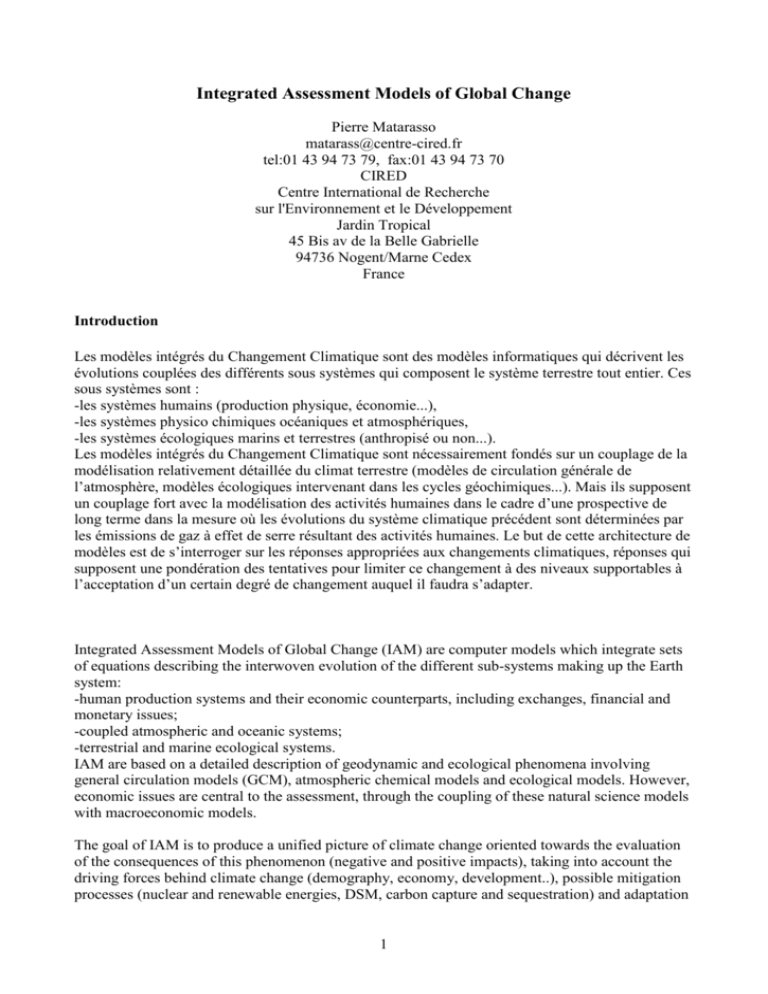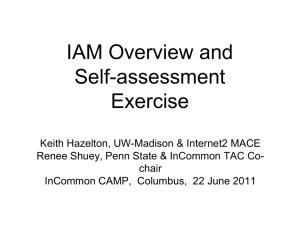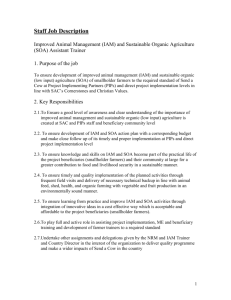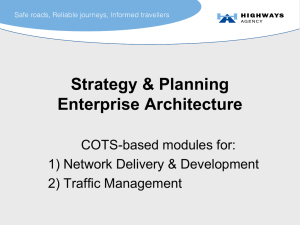Integrated Assessment Models of Global Change
advertisement

Integrated Assessment Models of Global Change Pierre Matarasso matarass@centre-cired.fr tel:01 43 94 73 79, fax:01 43 94 73 70 CIRED Centre International de Recherche sur l'Environnement et le Développement Jardin Tropical 45 Bis av de la Belle Gabrielle 94736 Nogent/Marne Cedex France Introduction Les modèles intégrés du Changement Climatique sont des modèles informatiques qui décrivent les évolutions couplées des différents sous systèmes qui composent le système terrestre tout entier. Ces sous systèmes sont : -les systèmes humains (production physique, économie...), -les systèmes physico chimiques océaniques et atmosphériques, -les systèmes écologiques marins et terrestres (anthropisé ou non...). Les modèles intégrés du Changement Climatique sont nécessairement fondés sur un couplage de la modélisation relativement détaillée du climat terrestre (modèles de circulation générale de l’atmosphère, modèles écologiques intervenant dans les cycles géochimiques...). Mais ils supposent un couplage fort avec la modélisation des activités humaines dans le cadre d’une prospective de long terme dans la mesure où les évolutions du système climatique précédent sont déterminées par les émissions de gaz à effet de serre résultant des activités humaines. Le but de cette architecture de modèles est de s’interroger sur les réponses appropriées aux changements climatiques, réponses qui supposent une pondération des tentatives pour limiter ce changement à des niveaux supportables à l’acceptation d’un certain degré de changement auquel il faudra s’adapter. Integrated Assessment Models of Global Change (IAM) are computer models which integrate sets of equations describing the interwoven evolution of the different sub-systems making up the Earth system: -human production systems and their economic counterparts, including exchanges, financial and monetary issues; -coupled atmospheric and oceanic systems; -terrestrial and marine ecological systems. IAM are based on a detailed description of geodynamic and ecological phenomena involving general circulation models (GCM), atmospheric chemical models and ecological models. However, economic issues are central to the assessment, through the coupling of these natural science models with macroeconomic models. The goal of IAM is to produce a unified picture of climate change oriented towards the evaluation of the consequences of this phenomenon (negative and positive impacts), taking into account the driving forces behind climate change (demography, economy, development..), possible mitigation processes (nuclear and renewable energies, DSM, carbon capture and sequestration) and adaptation 1 processes (changes in production methods in agriculture, protective infrastructures, etc.). IAM of very different sizes and levels of detail have been developed (Dowlatabadi, 1995; Rotmans, 1998; Janssen, 1998). It should be stressed that the question raised by IAM is in essence a problem of decision-making involving a public good (the atmosphere) at a global level in a uncertain context, where the measures against climate change and their consequences are spread over much of the earth surface in an extended time frame. The purpose of IAM is to integrate all these measures against climate change, and its positive or negative impacts in a global framework. The aim of this integration is to define an indicator of efficiency for each possible strategy involving mitigation and adaptation measures, summing up costs and benefits of these measures at a world level and over the entire time scale of climate change. In other words, IAM are devoted to climate policy analysis and in particular, to the computation of optimal emission trajectories. This problem concerns the most complex object science has ever had to cope with: Planet Earth. Therefore IAM raise an important philosophical question : what are the scientific limits to the knowledge of our planet, considered as a complex system? Which parameters of our future action regarding climate change can be selected according to reason and reliable arguments ? IAM constitute an attempt to transcend providence or intuition in the decision and negotiation processes concerning climate change. More specifically, IAM constitute an attempt to find answers to the following questions: (1) what are the best economic compromises involving measures designed to limit climate change and adaptation to it ? (2) What is the optimum distribution of the burden of mitigation and adaptation measures over different parts of the world? (3) How do we combine institutional measures, such as taxes, tradable permits and subsidies to technical innovation to stabilise GHG emissions at a safe level? A typical problem addressed by IAM is to analyse when, where, and how to react to climate change in order to satisfy ethical and economical principles such as the precautionary principle, cost benefit analysis or cost efficiency analysis. More generally, the dynamic aspects of global change are studied in the framework of IAM with the intention of assessing the relative importance of the various uncertainties pertaining to that phenomenon. The epistemic community presently gathering around IAM has reached a broad consensus of opinion on the questions the integrated models should address. However, in contrast, the technical solutions to these problems are extremely diverse, due to the complexity of the system under study. Therefore the range of problems addressed by IAM will probably remain stable for some time while model-building techniques will rapidly evolve. We will attempt to sum up this consensus before introducing some of the general technical aspects of IAM. 1-The paradigm of decision-making in facing Global Climate Change: when, where and how to act? The parameters of action against climate change are subjected to flexibility. Therefore if we decide to act against climate change, the problem appears extremely complicated, as we have to answer at least three classes of questions related to the nature of the different institutional and technical measures. The questions are: -when are measures against climate change required? -where are measures required? -what kind of measures are needed ? (Manne & Richels. 1995) 2 In addition, measures should be evaluated in proportion to their consequences in terms of impacts. Impacts are obviously linked to the atmospheric levels of GHG which result from each set of measures. Each of the preceding questions can be subdivided into many subtle problem areas, not the least of which is the fact that measures as well as their consequences in terms of impacts must be analysed at three separate levels: a)the physical level, b)the direct economic level, c)the indirect macroeconomic level of effects induced by mitigation policies and climate change impacts. 1-1 When to act or the timing problem? The elaboration of a set of institutional measures (taxes, quotas, tradable permits, innovation incentives) and related technical measures over time (mitigation and adaptation processes) is determined by the speed and level of climate change, technical progress, R&D expenditure, demography, economic development, etc. For example, IAM can be used to evaluate and compare a package of precautionary measures and a package of follow-up measures with various temporal horizons associated with different final states regarding GHG concentrations and different levels of climate change. The use of IAM has shown that many different paths (with various emission and mitigation profiles) can produce the same results in term of final atmospheric concentration of GHG. Therefore decision makers have to elaborate and compare sets of measures, with contrasting time-scales, which can lead to different global social costs. The determination of an optimal level of action, representing a good mix of mitigation and adaptation measures is sought. This is an area where the use of IAM has, directly or indirectly, structured and informed the international debate concerning the timing of policy measures (Wigley et al., 1996). 1-2 Where to act and spatial flexibility? The possibilities of reducing the emissions of GHG are distributed throughout the different geographical regions and nations of the world. If we assess the costs of these reductions it might appear that some geographical areas present, for technical and economic reasons, potentially cheaper mitigation possibilities than others. In this context a strategy of mitigation can be viewed as a set of technical operations indexed by geographical location and time scale, where these operations are ordered by increasing costs. Determining such strategies is one of the main goals of IAM. 1-3 How do we act on a technical level and trade-offs in the mitigation process? On a technical level, mitigation measures include a number of potential components: - at the level of energy demand (demand side management or DSM) ; - at the level of energy production (renewable or nuclear energy, more efficient energy conversion, CO2 capture devices, etc. ); - at the level of the creation of CO2 sinks (tree planting, induced algae production...) ; -mitigation measures could be distributed amongst the different GHG (CO2, CH4,N2O,SF6, PFCs, HFCs), with possible trade-offs between these gases . Many IAM are formulated to suggest least-cost packages of technical mitigation measures integrating various possible trade-offs and compromises between the different technical options. 3 1-4 What kind of public policy will trigger an appropriate association of technical options? In many past studies related to energy issues, energy options were considered on the basis of technical scenarios. The shift from technical scenarios to reality was accomplished through planning and national policy formulation. This view is no longer valid in the present context of competition on energy markets. In negotiations concerning climate change the discussion has progressively shifted from an approach centred on technical scenarios to the definition of public policies in term of economic procedures and legal agreements. One of the goals of many IAM is to test different economic taxes and permit regimes (distribution of entitlement to emission rights, quotas and ceilings of emissions, effects of differing flexibility mechanisms such as "Clean Development Mechanism" (CDM). Simulation of permit trading or of progressive carbon taxes and their interaction with development, growth, economic processes, technical progress, world markets of goods and capital are central to many IAM concerns. Equity issues play a major part in the evaluation of simulation results. 1-5 Evaluation of the climatic impacts of different packages of measures. New climate patterns can be very diversified and this may, in turn, have various consequences on economic activities. Categories of impacts can be divided into the negative and positive impacts that can affect different societies at different moments in time. Typical forms of climate events producing damages or negative impacts are: -hurricanes and tornadoes or different types of extreme weather events, -droughts or floods; -rises in sea level; Possible positive impacts are -Lengthening of growing seasons; -CO2 fertilisation of plant growth, -improved rainfall in dry areas... IAM provide a quantified description of impacts and evaluations of regional consequences through climate patterns, calculated with GCM fed with GHG concentrations resulting from sets of measures and actions. Particularly important is the study of the impacts of climate change on economic activities and possible adaptations (Tol, 1996). 1-6 Evaluation of the cost and macro economic consequences induced by mitigations or adaptation measures and impacts. It should be noted that each pattern of measures and impacts of climate change has a profound influence on economic issues. A few examples will illustrate this point: -the reduction of individual car use through switching towards other transportation modes might have a knock-on effect in the entire economy (with, for example, reductions in car production and a slowing down of individual transportation related activities in services such as garages, gasoline distribution, etc.) - limiting energy consumption might depress energy prices, which could be detrimental to oil producing countries. On the contrary, measures based on CO2 capture will not affect energy markets; -promoting a new international market of permits can have a marked influence on the mobility of capital. -reduction in agricultural production may result in economic decline and migration. 4 2- IAM mathematical structure In the absence of a general theory of modelling, only a very simplified description of the technicalities and issues concerning the working of IAM can be given. An IAM is a computer model, but a model made up of many intricate phenomena belonging to the natural and human domain. It is an assemblage of very heterogeneous processes. In some IAM, different sub models are linked, in others equations representing the different phenomena are more truly integrated. Such models may be described from different viewpoints. The first viewpoint is thematic; it consists of an individual description of the rather independent "sub-models" or models at a lower level coupled in the global model (equations grouped in themes and linked by common variables). The second viewpoint concerns purely methodological considerations independent of the classes of the phenomena described by sets of equations and involves a more fundamental definition of types of equations. The third viewpoint is related to solving procedures. In order to be useful, a model should produce a solution; and yet, different solving procedures are available for a given model, depending on the questions put to the model. From this latter viewpoint, IAM are very different from natural science models that do not raise the issue of decision-making and hence the study of many alternative scenarios that will never materialise in the real world. The problem of decisionmaking in a context of indeterminacy and uncertainty is at the core of IAM resolution and computing (see Dowlatabadi, 1995; Rotmans, 1998; Janssen, 1998). In order to understand the way in which IAM work and especially procedures to solve them, the second viewpoint should be adopted. 2-1 General structure of IAM. An IAM is a set of equations describing the evolution over time of the Earth system as a whole. Basically an IAM is a dynamic model, which implies the following types of equations, illustrated by simplified examples: -equations concerning evolution, linking one period to the next period. For example, the equation which establishes that the level of concentration of CO2 is dependant on emissions, mitigation and on the different natural processes of absorption of this gas. Other classic equations in the same category involve the evolution of capital goods through investment, obsolescence and dismantling, and descriptions of demographic change according to birth and death rates. -equations linking contemporaneous variables; equations linking GHG concentrations to global temperature; the relationships between damages and global temperature. In the economic domain, production expressed as a function of various factors such as available capital and available manpower; emissions calculated as a function of global production; constraints stipulating that consumption and investment should not exceed total production at a given time. Concerning variables, it is usual, in the first instance, to distinguish between: - flow variables (emissions, CO2 captured by forests and biomass, final consumption, investment, death and birth.); - stock variables (atmospheric level of CO2, levels of various capital stocks, population figures). This is only a rough classification as some variables which play a major role in quantification of flows are neither stock variables nor flow variables. Good examples of such variables are the temperatures in GCM and prices of goods in the economic section of IAM. In a simplified interpretation of these classifications of equations and variables, it can be argued that the equations 5 of evolution describe the evolution of stock variables as a function of the values of the relevant flows. In the past, models were often expressed in continuous time (and treated as systems of differential equations), especially natural science models such as GCM. Today many factors favour the expression of models in discrete time (with finite difference equations): -the models are too complicated to be treated analytically and the calculation of results requires the use of computers that rely on discrete computations; -at the level of the earth, natural discrete periods already exist, such as the seasons or the farming year and budgeting within industry and services; -the treatment of discrete events implies the use of discrete time periods. Many IAM are therefore expressed in a discrete time framework. In some models, different time scales could be used since geodynamic phenomena often involve shorter time periods than economic processes. 2-2 Solving procedures in IAM Basically two types of solving procedures are used in IAM -recursive solving through sequential simulation; -intertemporal solving through optimisation. The principle of recursive sequential simulation is fairly straightforward: with prescribed initial conditions, the state of the system at t+1 is computed from the state at t, by introducing values for flows in the evolution equations. Some of these flows are defined as "control variables" or “policy variables”. In simulation these control variables will be given through an exogenous control scenario (such as, for example, a mitigation policy). It should be noted that all flows should be specified to arrive at a determinate evolution of the system represented. The calculation follows the temporal order of the real pattern of events and simulates change. The principle of intertemporal solving through optimisation is different. A system of simultaneous equations is established by duplicating, for all periods, the group of equations valid for one period (equations of evolution and contemporaneous equations). Initial conditions and, eventually, final conditions are defined. This system of simultaneous equations expressed for n periods, with time indexes for each period, is then solved globally as a whole (and not sequentially as in ordinary simulation), generally through optimisation algorithms. The main difference between the two approaches lies in the treatment of decision-making. In simulation, in order to impose a determinate evolution, all the decision variables (usually flow variables, such as investment decisions in the energy field) have to be defined exogenously by a scenario. This is why simulation models are considered as models of policy evaluation. The evaluation centres on the scenario (mitigation and adaptation policies, emission permit policy) fed into the model and its consequences in terms of climate change impacts. On the contrary, in intertemporal solving procedures, some of the possible decision variables are "left free" and a determinate evolution is computed in which the algorithm selects an optimal control, that is a complete set of control variables covering the whole time scale. Optimisation is achieved by selecting a temporal evolution by computation which maximises an intertemporal function, usually an economic welfare function expressed by a discounted sum, over all periods of consumption at each period. In this framework, running the model results in the selection of a coherent optimal set of decisions throughout the whole time scale (mitigation and adaptation measures, or least cost 6 mitigation for a given target of final GHG concentrations) including consequences in terms of damages, cost and benefits. This is why this procedure is termed "optimal policy definition". It should be stressed that in the optimisation framework, various constraints on the final period (stable final concentrations of GHG for example) can be specified and computation produces solutions respecting these constraints (or the optimisation algorithm yields the result that it is impossible to find such a solution). On the contrary, in simulation, the scenario submitted to computation produces end conditions that could not be anticipated. This is why simulation might lead to "overshoot and collapse" not previously envisaged in the scenario submitted. In other words, simulation is "blind" or "short sighted" and optimisation in some respects is “forward looking” and mimics behaviour with expectations or perfect foresight, where decisions are taken with a knowledge of their consequences. This last peculiarity is especially important when tradeoffs between decisions over a longer time scale are envisaged. In theory, any dynamic model structure (if by model we mean the core structure of the equations) can be solved either way. In practice, our ability to compute intertemporal optimisation is limited to simplified models for a basic reason: an optimisation algorithm explores an infinite number of alternative solutions whilst simulation computes only one solution at a time. Optimisation therefore requires much greater computing power. Other model solving procedures should also be mentioned, especially the "inverse" mode in which a solution is computed in a reverse temporal order, with a final state taken as "initial conditions". For an excellent example of policy optimisation models see Nordhaus (1994) who introduced this paradigm in the field of climate change. An example of a leading simulation and policy evaluation model, IMAGE, can be found in Alcamo (1994). 3-Current debates concerning IAM structure and uses 3-1 Cost benefit analysis versus cost effectiveness analysis Evaluation of impacts is one of the weakest elements of IAM. Impact evaluation raises very complex problems due to the many uncertainties of climate models for long-term forecasts. Some IAM try to integrate the cause (human activities), modification of the cause (mitigation of emissions), consequences (climate change impacts) and adaptation to consequences (adaptation to climate change) in the framework of cost-benefit analysis (CBA). Costs are related to mitigation, adaptation or damages and benefits to avoided damages or more favourable climate conditions. But due to the huge uncertainties concerning physical impacts, evaluation of adaptation costs, many models of a lower level of integration adopt a cost effectiveness analysis framework (CEA). In such cases the aim is to reach a given stable final concentration target of each GHG or to satisfy mitigation objectives at least cost. (Bruckner et al. , 1999). 3-2 The "top down" versus "bottom up" debate The level of description of economic phenomena, especially energy systems, is a much debated question in IAM. Traditionally there are two opposing approaches, "top down" and "bottom up" modelling. Top down models synthesise major tendencies in economic trends such as demography, economic growth, investment, consumption and a fairly crude indicator of trade. In a top down 7 IAM context, geodynamics are aggregated and damages are dealt through damage functions in a global context. Bottom up models involve the detailed description of components of economic systems, usually energy systems, in terms of elementary process analysis. When IAM are developed from a bottom up perspective, damages are also usually more detailed and their evaluation takes into account the temporal and geographic peculiarities of climate change and their consequences on agriculture, industry and housing. When insights regarding timing of action are sought or when a broad geographical distribution of the burden of mitigation is envisaged, order of magnitude analysis is often a prerequisite. In this case top down models are used. But if the question involves precise mitigation options with tradeoffs between different energy technologies (nuclear, renewable, DSM ), trade-offs between gases (CO2, CH4,N2O,SF6, PFCs, HFCs), and trade-offs between reductions of emissions and capture of CO2 by tree plantation, bottom up models are absolutely necessary. Only a bottom up model can break down a global mitigation effort into a sequence of precise technical decisions with time and regional indexes. Increasingly, the frontiers between top down and bottom up models are vanishing; some models incorporate a bottom up description of the energy or production sector (for example the MERGE model, and MARKAL family models) within a top down framework for the whole economy. For the foreseeable future, bottom up models will raise questions concerning data availability and computation. Even if they seem more satisfactory from many points of view, it will be a long time before they are fully effective (Dowlatabadi, 1995; Janssen, 1998). 3-3 Uncertainty Uncertainty is the thorniest issue in the IAM field; and it does not appear that a consensus has yet been reached. However, some methodological trends can be identified. They range from a strict application of the precautionary principle to more classic applications of decision-making in the framework of uncertainty theory. The treatment of uncertainty causes difficult problems in computation, as uncertainty adds many dimensions to the search for sustainable development solutions. Also the question of whether a reduction of uncertainty through research and development is possible has to be raised. Usually two general categories of uncertainty are defined: -parametric uncertainty that stems from imperfect knowledge, -stochasticity due to natural variability. Significant uncertainties occur, for example, in demographic behaviour, damage functions, energy efficiency trends and in endogenous technical progress. The discount rate (policy choices are very sensitive to the discount rate) and information costs (funds spent to reduce uncertainty) are important issues in the uncertainty debate. On the important subject of discounting see Portney & Weyant (1999). It should also be noted that uncertainty is a major issue in the debate on the timing of mitigation; uncertainty acts in favour of precautionary action, especially in the case of high inertia of energy systems (Ha-Duong et al. , 1997). Various ways (with many intermediate levels) of treating uncertainty have been developed: -a systematic treatment of uncertainty using rigorous mathematical techniques such as stochastic dynamic optimisation, -application of the precautionary principle and the "viability" approach through inverse problem methodology, where sustainable approaches in an uncertain context are established through a "reverse" computation (Tolerable Window Approach) 8 -exploring a large number of alternative problem formulations with different sets of risk events (cultural theory). (Kann and Rotmans, 1998) 3-4 The "when and where" flexibility debate In a cost-effectiveness framework, one of the hotter questions is the search for the best allocation of mitigation in space and time. Use of IAM has shown that the answer to these questions can be far removed from a "first guess", which is usually to begin action as soon as possible and in the countries with higher levels of energy consumption. In fact there are many arguments in favour of delayed action. For example, it seems justified to await the effect of technical progress, the end of life of current energy installations, a better understanding of the real effect of climate change and to take advantage of a discounting effect. Delayed action appears to have some advantages in economic terms when tested through IAM. In space it is best to allow some degree of flexibility (with emission permits or Clean Development Mechanism) in order to take advantage of the lowest mitigation costs available at a world level. The idea of flexibility in time has been called into question when dynamic effects such as the increased cost of mitigation are introduced into the scenario, where rapid mitigation is required (if impacts turn out to be worse than previously expected). The "when and where controversy" is a typical example of a debate which has developed from insights introduced by IAM. Such a debate stemmed from the use of intertemporal IAM that showed that the introduction of flexibility in time and space favours lower global social costs in climate change (Wigley et al. , 1996; Ha-Duong et al. , 1997). 4-IAM in the context of history of science 4-1 World dynamics As previously stated, the idea of constructing models of what is, perhaps, the most complex object ever considered in science, planet Earth, raises many epistemological questions. For some scientists, this attempt is still illegitimate. The idea of comprehensively integrating global phenomena is not new and the first approach of this type was both highly praised and strongly denigrated (see Forrester, 1971; Club of Rome, 1972). The two above books met with a very mixed response. Widely accepted by the public and the media, they were rejected by many earth scientists and economists. Notwithstanding an inadequate appraisal of the Earth's complexity (through the concept of static limits, the use of differential equations and deterministic system dynamics, inadequate economic representation, etc.), these two books should receive due credit as the first attempt to think globally about the future of planet Earth. As such they influenced many of the contemporary model builders. But the criticisms levelled were equally important in developing lines of argument that still apply to the new generation of models: -the data are insufficient, -knowledge of the differing phenomena is grossly approximate, -in running models, many elements, ranging from the inadequate treatment of uncertainty to deterministic chaos and multiple equilibriums, alter the dynamic. 9 However, although they seem justified at first sight, these critiques do not suggest any alternative. The problem is complex and so are the methods devised to treat it. Therefore we should make the effort to analyse both the limitations and the merits of IAM. The models should not be considered as "truth machines", but as the best (and only) means we have to elaborate complex arguments related to a complex problem. In this context models should be viewed as "arguments in form", integrated into the framework of provisional knowledge, with the intention of defining action, rather than as a faithful mirror of the essence of the phenomena. At best, IAM should be seen as providing order of magnitude modelling, comparison of policy scenarios and forecasting of trends, but not prediction. 4-2 A new dimension in science The attempt to construct a predictive or a decision-making model at the level of an object as complex as planet Earth opens an entirely new field in science. We should first underline the paradox produced by this attempt. Since the 16th century the study of the universe and the cosmos has been a miraculous success. The study of the terrestrial environment and complex ecologies is only just beginning. The cosmos is, in some ways, more familiar than the oikos (Greek term from which ecology and economy derive). The part seems more complex than the whole. Clearly planet Earth is almost unthinkable in its complexity, especially in the context of decision-making. However, unfortunately, the human impact on the terrestrial environment through climate change has obliged us to focus on this objective. Such complexity defies the very element which underpins the success of modern science since Galileo: the reduction of the complex to simple components. The scientists of the 17th and 18th centuries provided a new understanding which led to the development of modern science through a straightforward metaphysical principle: the superior being who created the world founded this creation on reason and simplicity, and based it on mathematics. The way to understand this world was to apply a platonic principle: to look for what did not change in the change itself and express this in mathematical form as the laws of change. The quest for invariance, symmetries and conservation principles opened up a new avenue in the discovery of mathematical principles underlying phenomena at a cosmological level. This constituted the origin of differential calculus. Such an approach led to the successful unification of the earth and the heavens under the universal laws of physics. This replaced Aristotelian physics, which precedes modern science, in which the earth and the heavens were governed by different principles. The approach of the new physics of the 17th and 18th century did not, however, provide an answer to some of the problems which have been raised since Aristotle's time and which are still relevant at a terrestrial level (in ecology and economy). From the 17th to the 20th century, the mathematisation of reality borrowed most of its principles and style from a mechanical model, that is to say mathematical modelling of movement, or "kinesis" (and associated systems of differential equations). But at the level of global reality there is a form of change other than the change of place. This other type of change is designated by Aristotle as "genesis". In genesis, new beings differing from those preceding are created and the “ways of changing” constantly change, in part because of the introduction of these new beings. Modern IAM are still confronted with the major difficulty of the temporal heterogeneity of dynamic phenomena. Some scientists who paved the way for modern integrated assessment models, such as Von Neumann, Georgescu Roegen or Casti, underlined the fact that models of reality at a global level should depart from the classical platonic discourse concerning phenomena (search of invariance and mathematical realism) and return to a new form of Aristotelianism (formalisation of reasoning 10 through logic on reality with deep qualitative changes). Besides the question of genesis at a terrestrial level (as underlined by Casti), not everything can be explained by a single cause, "the efficient cause" (a cause entirely defined by ordinary state variables), as in the mathematisation of movement. Other forms of cause such as the Aristotelian "formal causes", that is phenomena guided by programs or internal representation, should be reconsidered. Therefore some new principles should be introduced in models of the phenomena at earth level, notably: -discrete events : events which cannot be submitted to an infinite division; a move in a game, the process of formation of an animal and the construction of a factory are examples of such events. -formal causes: the evolution of living creatures implies a program such as a genetic code; the evolution of human societies implies intention, will, anticipation and programmes of action founded on symbolic representations by economic actors. -indeterminism; the evolution of social phenomena depends on decisions taken by economic actors or agents. In this context, classical laws of evolution only partly determine the global phenomena integrating natural events and human activities. In this sense the evolution of the Earth system is indeterminate as it involves decision-making. This new context pervades the IAM attempt to represent global phenomena. More precisely, the problem is no longer to define a phenomenology of the Earth's evolution, which treats this phenomenon as something exterior to humankind, on which we have no action, akin to planetary motions. On the contrary we have to study very diverse trajectories which will never materialise, apart from the one that will derive from our decisions or actions. In this sense the main object of IAM is to set up realistic fictions to facilitate decision-making. This selfcontradictory expression raises many questions: what are the realistic criteria in representing a very complex and heterogeneous object and what is the optimum level of detail in the fiction? The prevailing belief in classical science of the quasi-perfect adherence of the mathematical model to the phenomena (such as in mechanics and electromagnetism), no longer applies, and this leads to many epistemological enigmas. All these peculiarities are responsible for major difficulties in model building (in articulating a deterministic view with alternatives and uncertainty in decision-making), in model calibration (calibration of sequences of events far from known situations), in running models (protocols for running models devoted to policy definition). Some scientific resources exist to treat these problems, occupying a position between logic and differential calculus. Important sources of inspiration may be provided by operational research and optimal control theory. Bibliography Alcamo J. ed. (1994) IMAGE 2.0 Integrated Modeling of Global Climate Change. Kluwer Academic Publishers : Dordrecht, Boston, London Bruckner T. & al (1999) Climate change decision support and the tolerable window approach. Environmental Modeling and Assessment, 4 :217-234 Dowlatabadi H. (1995) Integrated assessment models of global change. An incomplete overview. Energy Policy, vol 23, number 4/5 : 289-296. Forrester J.W. (1971) World Dynamics, Wright-Allen Press, Inc, Cambridge, Mass. Ha-Duong M., Grubb M. J., Hourcade J.C.( 1997) Influence of socio-economic inertia and uncertainty on optimal CO2 emission abatment. Nature, 390 :270-274. 11 Janssen M. (1998) Modelling Global Change : The Art of Integrated Assessment Modelling. Edward Elgar : Cheltenham, Northampton. Kann A. Weyant J.P. (2000) Approaches for performing uncertainty analysis in large scale energy/economic policy models. Environment Modeling and Assessment, 5 :29-46 Manne A., Richels R. (1995) The greenhouse debate : Economic efficiency, burden sharing and hedging strategies. The Energy Journal, vol 16, n84 : 1-37 Nordhaus W.D. (1994) Managing the Global Commons. The MIT Press : Cambridge MA; London. Portney P.R. and Weyant J.P. eds. (1999) Discounting and Intergenerational Equity. Ressource For the Future : Washington DC Rotmans J. (1998) Method for IA : the challenges and opportunities ahead. Environmental modeling and assessment 3 :155-180. Schellnhuber H.-J. Wenzel (1998) Earth System Analysis, Integrating Science for Sustainability. Springer-Verlag :Berlin, Heidelberg, New York. Tol R.S.J. (1996) A Decision-Analytic Treatise of the Enhanced Greenhouse Effect, Vrije Universiteit : Amsterdam. Wigley T.M.L., Richels R. & Edmonds J.A. (1996) Economic and environmental choices in the stabilisation of atmospheric CO2 concentrations. Nature, 379 : 240-243 12






